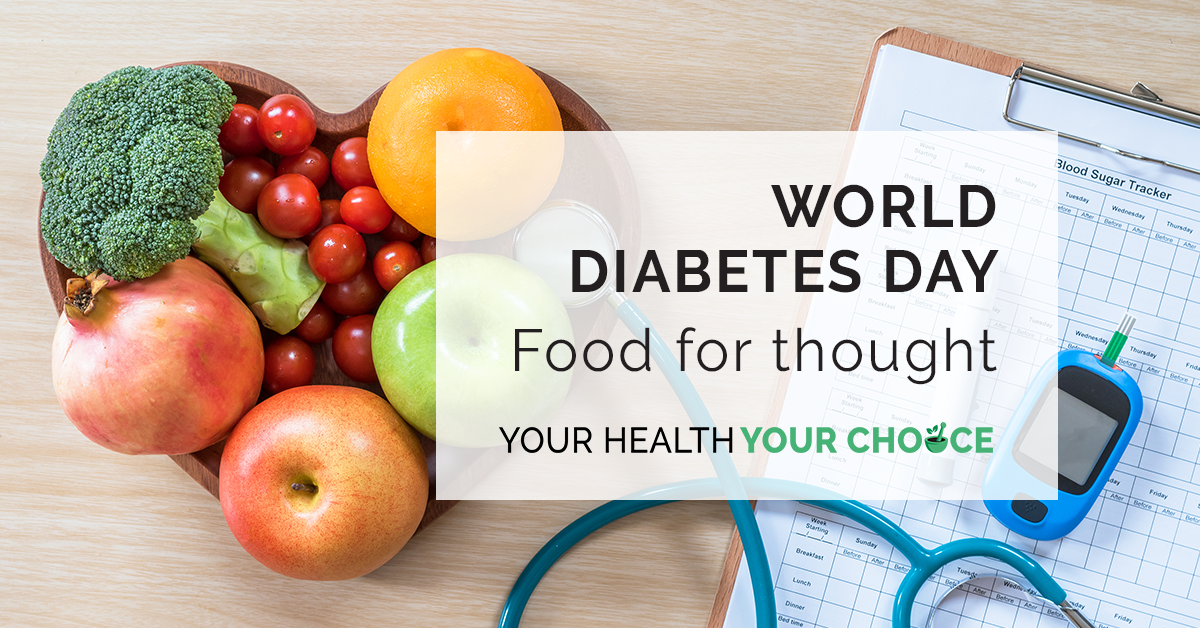Diabetes – Food for Thought

The increasing prevalence of diabetes represents a significant disease burden in Australia. In 2018, over one million Australian adults were living with this diagnosis. On a positive note, there is growing evidence that certain nutritional guidelines used in an integrative approach may reverse type 2 diabetes (T2D).1
Diabetes is a group of diseases characterised by elevated blood glucose levels due to defects in insulin secretion, insulin action, or both. Usually T2D begins with insulin resistance often stemming from obesity, which is known as the pre-diabetic state. Keep in mind that glucose is the essential fuel needed by our cells to function.
Insulin helps control the amount of glucose in the blood and with insulin resistance, the body’s cells do not respond properly to insulin and cannot take up glucose from the blood to be stored in cells for energy. Then the pancreas secretes extra insulin to maintain normal glucose levels. As the disease progresses, the β-cells of the pancreas fail to adequately compensate for insulin resistance and eventually no insulin is produced.
This means glucose can no longer be removed from the blood (hyperglycaemia). This is now a stage of toxicity and symptoms begin to develop. Risk of damage to the pancreas, myocardial infarction, stroke, microvascular events, and mortality increases dangerously.
The β-cell dysfunction progresses over time and is well advanced by the time a person’s plasma glucose level is in the diabetic range and continues to worsen after diabetes develops.
Classic T2D symptoms:
- extreme thirst or hunger
- hungry even after a meal
- increased or frequent urination
- tingling in hands and feet
- fatigue
- frequent skin infections that are slow to heal
- blurred vision
Controlling diabetes is important to prevent serious long-term complications such as:
- heart and circulation problems
- infections
- kidney disease
- eye problems, which can lead to blindness
- nerve damage to the lower limbs and other parts of the body
What is the best approach?
It is widely accepted that nutrition is the cornerstone to diabetes care, however there are significant differences in approach and methodology within this field.
The three key treatment protocols centre on healthy eating and the following outcomes:
- Achieve and maintain body weight goals
- Attain individualised glycaemic, blood pressure, and lipid goals
- Delay or prevent complications of diabetes
Evidence is starting to point more at the quality of the macronutrients (carbohydrates, fats, proteins) rather than the quantity to achieve the above outcomes.2 Eating regularly across the day will also help keep glucose levels stable.
Carbohydrates – yes or no?
A resounding yes! But if they are nutrient-dense carbohydrates that are high in fibre, including vegetables, fruits, legumes, and whole grains. The foods you need to let go of are refined ‘white’ breads, pastas, rice, noodles, biscuits, and pastries.
Carbohydrate metabolism is at the heart of diabetes. When people eat a food containing carbohydrates, the digestive system breaks down the digestible ones into sugar, which enters the blood.
Fibre is the diabetics’ best friend as it slows down the rate at which carbohydrates are broken down, and the rate that the body absorbs the resulting sugars. Intake of dietary fibre is associated with lower mortality in people with diabetes.3
Carbohydrate quality can be determined by evaluating the glycaemic response to carbohydrate-rich foods such as the glycaemic index (GI) and the glycaemic load (GL). You can use the GI calculator from the Sydney University.
Carbohydrates with a low GI value (55 or less) are more slowly digested, absorbed, and metabolised and cause a lower and slower rise in blood glucose and, therefore insulin levels. Low GI diets have shown to help with weight management and improve blood cholesterol levels.4
The amount of carbohydrate you need each day depends on many factors, such as your age, gender, weight, and activity levels. The standard amount for women is 30-45g, and for men it is 45-60g, per day.5
Avoid sugar-sweetened beverages (including fruit juices) to control glycemia and weight and reduce their risk for cardiovascular disease and fatty liver. Avoid the consumption of foods with added sugar that have the capacity to displace healthier, more nutrient-dense food choices.
The low-down on fats
Findings highlight the important role of quality dietary fat in the prevention of cardiovascular disease and total mortality among people with T2D.6
Again, the key word here is quality. Healthy fats, (including avocado, extra virgin olive oil, coconut oil, grass fed butter, nuts and seeds, oily fish including wild caught salmon, sardines and mackerel), are essential for diabetics for a range of reasons.
When incorporated with a balanced meal, the fat slows the spiking of blood glucose. This reduces the effects of the carbohydrates within a meal.
These healthy fats also have anti-inflammatory compounds essential to keep the cardiovascular system healthy.
However, hydrogenated (trans) fats are diabolical to human health. When plant oils are hydrogenated (to make them thicker and creamier), the molecular shape of the remaining unsaturated fats has been rearranged.
This unhealthy, inflammatory fat dramatically increases risk of cardiovascular disease. It raises your “bad” cholesterol while reducing your “good” protective cholesterol. So please check labels (it is in almost all packaged and processed food) and avoid margarines.
Stress is a killer
Stress has a significant impact on blood sugar levels. The body gives off stress hormones when under tension, and these hormones raise blood sugar levels. Stress will also dysregulate digestion as cortisol and adrenaline (key stress hormones) will be activated and result in diminished blood flow and function in the stomach and gastrointestinal tract. This is the fight or flight response of the sympathetic nervous system.
Research shows that managing stress through meditation and exercise can also help to lower blood sugar levels.7
Exercise is also an important factor and can contribute to weight loss, increase insulin sensitivity and help to reduce high cholesterol and blood pressure.
The take home message
Watch your weight to avoid insulin resistance, the slippery slope to T2D.
Insist that your physician support you in changing your diet and lifestyle before rushing you onto pharmaceuticals. The evidence supports lifestyle changes for optimal outcomes.
Eat a wholesome, nutrient-dense diet that includes plenty of fibre and avoid refined foods wherever possible. This will reduce the amount of glucose released into the bloodstream and keep blood glucose levels balanced. It also reduces inflammation.
Get on top of your stress, as it will cause more glucose to be released into bloodstream, disrupt every stage of digestion, and promote inflammation. Find joy and relaxation in everyday life.
Always seek professional support for qualified and individualised nutritional advice.
« Return to News & Features
